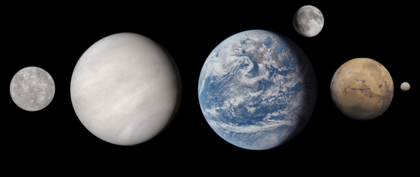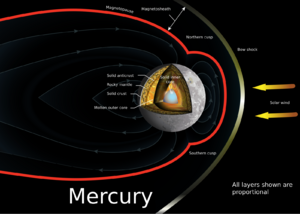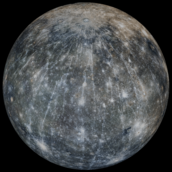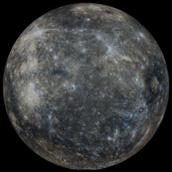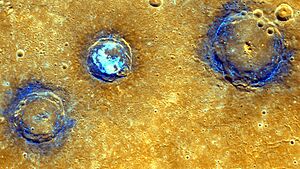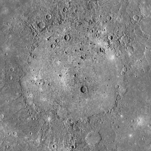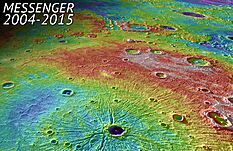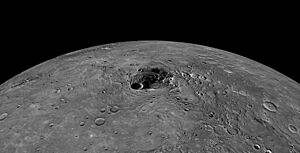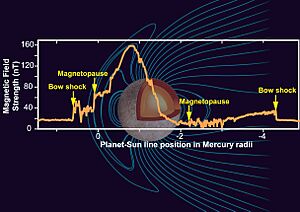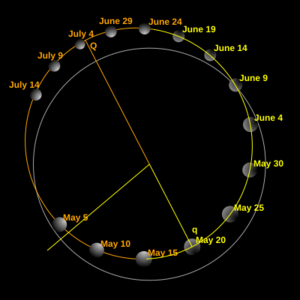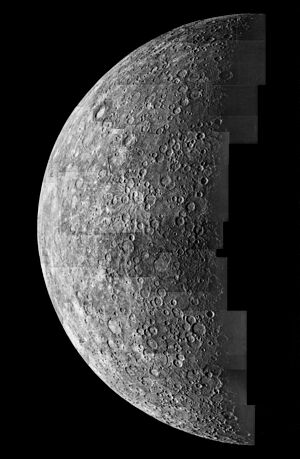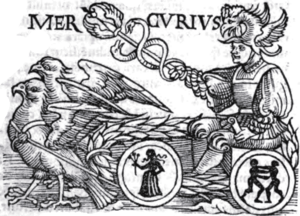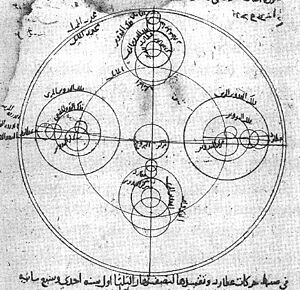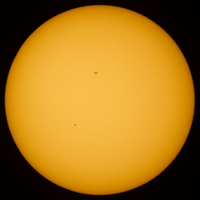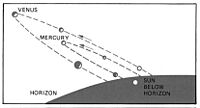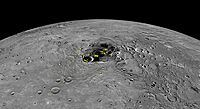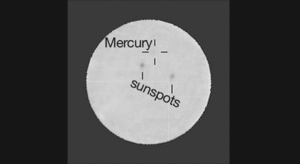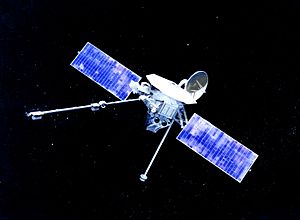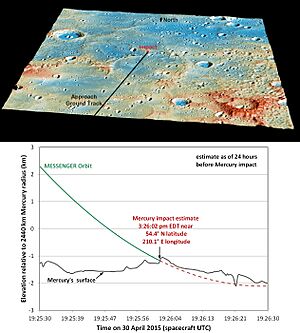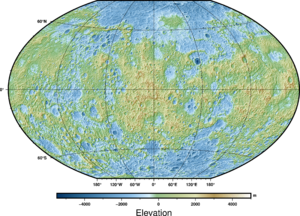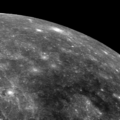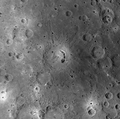Mercury (planet) facts for kids
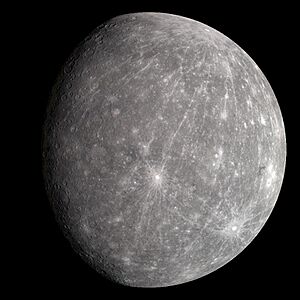
Mercury in true color (by MESSENGER in 2008)
|
|||||||||||||
| Designations | |||||||||||||
|---|---|---|---|---|---|---|---|---|---|---|---|---|---|
| Pronunciation | |||||||||||||
| Adjectives | Mercurian /mərˈkjʊəriən/, Mercurial /mərˈkjʊəriəl/ |
||||||||||||
| Orbital characteristics | |||||||||||||
| Epoch J2000 | |||||||||||||
| Aphelion | 0.466697 AU (69.82 million km) | ||||||||||||
| Perihelion | 0.307499 AU (46.00 million km) | ||||||||||||
| 0.387098 AU (57.91 million km) | |||||||||||||
| Eccentricity | 0.205630 | ||||||||||||
|
|||||||||||||
| 115.88 d | |||||||||||||
|
Average orbital speed
|
47.36 km/s | ||||||||||||
| 174.796° | |||||||||||||
| Inclination |
|
||||||||||||
| 48.331° | |||||||||||||
| 29.124° | |||||||||||||
| Satellites | None | ||||||||||||
| Physical characteristics | |||||||||||||
|
Mean radius
|
|
||||||||||||
| Flattening | 0.0009 | ||||||||||||
|
|||||||||||||
| Volume |
|
||||||||||||
| Mass |
|
||||||||||||
|
Mean density
|
5.427 g/cm3 | ||||||||||||
| 3.7 m/s2 (0.38 g0) | |||||||||||||
|
Moment of inertia factor
|
0.346±0.014 | ||||||||||||
| 4.25 km/s | |||||||||||||
| 176 d | |||||||||||||
|
Sidereal rotation period
|
|
||||||||||||
|
Equatorial rotation velocity
|
3.026 m/s | ||||||||||||
| 2.04′ ± 0.08′ (to orbit) (0.034°) |
|||||||||||||
|
North pole right ascension
|
|
||||||||||||
|
North pole declination
|
61.41° | ||||||||||||
| Albedo | |||||||||||||
| Temperature | 437 K (164 °C) (blackbody temperature) | ||||||||||||
|
|||||||||||||
| −2.48 to +7.25 | |||||||||||||
| −0.4 | |||||||||||||
| 4.5–13 | |||||||||||||
| Atmosphere | |||||||||||||
|
Surface pressure
|
trace (≲ 0.5 nPa) | ||||||||||||
| Composition by volume | |||||||||||||
Mercury is the closest planet to the Sun and the smallest planet in our Solar System. It is a rocky planet with a very thin atmosphere. Its surface looks a lot like Earth's Moon, covered in many craters. It also has long cliffs called rupes and bright streaks called ray systems from impacts.
Mercury orbits the Sun faster than any other planet. From Earth, it always appears close to the Sun, either as a "morning star" or an "evening star." It is also the planet that is most often closest to all other planets in the Solar System.
One day on Mercury (from sunrise to sunrise) lasts about 176 Earth days. This is twice as long as Mercury's year, which is 88 Earth days. This means one side of Mercury can be in sunlight for a very long time, getting extremely hot. The other side stays in darkness for just as long, becoming very cold.
Mercury has a very thin outer layer of gas called an exosphere and a weak magnetic field. Because of its unusual orbit and tiny tilt, some areas at its poles are always in shadow. Scientists believe water ice might be hidden in these dark craters.
Like other planets, Mercury formed about 4.5 billion years ago. Scientists are still studying how it formed and changed over time. It has a large iron core. Mercury is one of the classical planets, meaning people have seen it in the sky for thousands of years. It is named after the ancient Roman god Mercury, who was a fast messenger. Spacecraft like Mariner 10, MESSENGER, and BepiColombo have visited Mercury to learn more about it.
Contents
What's in a Name?
For a long time, people thought Mercury was two different stars: one seen in the morning and one in the evening. Around 350 BC, the ancient Greeks figured out it was the same planet. They called it "Stilbon," meaning "twinkling," or "Hermes," because it moved so quickly.
The Romans named the planet after their swift messenger god, Mercury. This name stuck because it's the fastest planet to cross the sky. The symbol for Mercury, ☿, looks like Hermes' staff, called a caduceus.
Mercury's Features
Mercury is one of the four terrestrial planets in our Solar System. This means it's a rocky planet, like Earth, Venus, and Mars. It's the smallest planet, with a radius of about 2,439.7 kilometres (1,516.0 mi). Mercury is even smaller than some large moons, like Ganymede (Jupiter's moon) and Titan (Saturn's moon).
Mercury is made of about 70% metal and 30% silicate material, which is like rock.
Inside Mercury
Scientists believe Mercury has a solid rocky crust and mantle. Below that, it likely has a solid outer core, a liquid core layer, and a solid inner core, all made of metal. Its core is probably rich in iron, with some nickel, silicon, and possibly sulfur and carbon.
Mercury is the second densest planet in the Solar System, after Earth. Its density is 5.427 g/cm3. This high density tells us that Mercury's core must be very large and full of iron. The core makes up about 57% of Mercury's total volume. For comparison, Earth's core is only about 17% of its volume.
The outer rocky layer (mantle and crust) is about 420 km (260 mi) thick. Mercury's surface has many long, narrow ridges. These probably formed as the planet's core and mantle cooled and shrank, causing the crust to wrinkle.
Scientists have different ideas about why Mercury has so much iron. One idea is that early in the Solar System, a huge planetesimal (a small planet-like object) crashed into Mercury. This impact might have stripped away most of Mercury's original rocky outer layers, leaving behind a large iron core. This is similar to how Earth's Moon is thought to have formed.
Another idea is that Mercury formed when the Sun was very young and extremely hot. The intense heat might have vaporized much of Mercury's rocky surface, and the solar wind then blew this "rock vapor" away. A third idea suggests that lighter particles were pushed away by the solar nebula (the cloud of gas and dust where planets formed) as Mercury was growing.
Space missions like MESSENGER and BepiColombo have been studying Mercury's surface to test these ideas. MESSENGER found more potassium and sulfur than expected, which suggests that the giant impact or vaporization might not have happened, as these elements would have been lost in extreme heat. BepiColombo, which arrived in 2025, is continuing these studies.
Mercury's Surface
Mercury's surface looks a lot like our Moon, with many flat plains and heavy cratering. This shows that its surface hasn't changed much in billions of years. It has areas with different brightness, including craters, material thrown out from impacts (ejecta), and bright streaks called ray systems.
Mercury also has "wrinkle-ridges," Moon-like highlands, mountains, plains, cliffs (escarpments), and valleys. The planet's mantle has different chemicals in different places. This suggests that Mercury had a magma ocean (a sea of molten rock) when it was young.
Features on Mercury are named by the IAU (International Astronomical Union). Craters are named after famous artists, musicians, and writers. Ridges are named after scientists who studied Mercury. Plains are named after the god Mercury in different languages. Cliffs are named after scientific expedition ships.
Craters and Basins
Mercury was hit by many comets and asteroids when it was forming, about 4.6 billion years ago. It also experienced a period called the Late Heavy Bombardment about 3.8 billion years ago. Because Mercury has almost no atmosphere, there was nothing to slow down these incoming objects, so they hit the surface hard.
During this time, Mercury also had volcanic activity. Molten rock (magma) filled large basins, creating smooth plains similar to the "seas" (maria) on the Moon. Craters on Mercury range from small bowl-shaped holes to huge basins hundreds of kilometers wide. They look different depending on how old they are, from fresh craters with bright rays to very old, worn-down ones.
The largest known crater is Caloris Planitia, or Caloris Basin, which is about 1,550 km (960 mi) across. The impact that created it was so powerful that it caused lava to erupt and left a ring of mountains about 2 km (1.2 mi) tall around the crater. The floor of the Caloris Basin is a flat plain with ridges and cracks.
On the exact opposite side of Mercury from the Caloris Basin is a strange, hilly area called the "Weird Terrain." One idea is that the shock waves from the Caloris impact traveled through the planet and met on the other side, breaking up the surface.
Plains and Cliffs
Mercury has two main types of plains. The older plains are gently rolling and found between craters. They seem to have covered up many older, smaller craters.
The smooth plains are flat areas that fill depressions. They look a lot like the lunar maria on the Moon. These smooth plains formed later than the Caloris basin and likely came from volcanic lava flows.
Mercury also has many long cliffs, called rupes, that cross its plains. These are much more noticeable than similar features on the Moon. As Mercury's inside cooled and shrank, its surface wrinkled, creating these cliffs. Some cliffs are up to 1,000 km (620 mi) long and 3 km (1.9 mi) high. These cliffs often cut across craters and plains, showing they formed more recently. Scientists believe Mercury's radius has shrunk by about 1 to 7 km (0.62 to 4.35 mi) due to this cooling.
Volcanoes
There is evidence of pyroclastic flows (explosive volcanic eruptions) on Mercury, forming low, wide volcanoes. Over 50 such deposits have been found, mostly inside impact craters. This suggests that volcanic activity happened on Mercury for a long time.
Inside the Caloris Basin, there's a unique area with at least nine overlapping volcanic vents. These vents are deep and look like they were formed by explosive eruptions or by the ground collapsing when magma moved away. Scientists think this volcanic area could be a billion years old.
Surface Conditions and Exosphere
Mercury's surface temperature changes a lot, from about −173 °C (−280 °F) at night to 427 °C (800 °F) during the day. At the poles, it never gets warmer than about -170 °C because the Sun's rays never reach the bottom of deep craters there.
Even though Mercury is very hot, scientists have found strong evidence of water ice at its poles. The floors of deep craters at the poles are always in shadow, creating "cold traps" where ice can build up. Radar observations in the 1990s showed bright patches near the poles that reflected radar strongly, suggesting ice. MESSENGER images later confirmed the presence of water ice in these craters.
Scientists estimate there could be 100 to 1,000 billion kilograms of ice in these craters. This ice might be covered by a layer of dust that stops it from turning into gas. The ice probably came from water vapor released from Mercury's interior or from comets hitting its surface.
Mercury is too small and hot to hold onto a thick atmosphere. Instead, it has a very thin layer of gas called an exosphere. This exosphere is not stable; atoms are constantly lost and replaced. It contains gases like hydrogen, helium, oxygen, sodium, and calcium. Hydrogen and helium likely come from the solar wind. Other elements come from the decay of radioactive elements in Mercury's crust or from micrometeorites hitting the surface. Water vapor is also present, possibly from comets or from water ice sublimating (turning directly into gas) from the polar craters.
According to NASA, Mercury is not a good place for Earth-like life. It has extreme temperatures, high solar radiation, and almost no atmosphere. It's unlikely that any living things could survive there. However, some scientists wonder if very simple microorganisms might have existed deep underground in the past.
Magnetic Field
Even though Mercury is small and spins slowly (one rotation takes 59 Earth days), it has a significant magnetic field. Measurements from Mariner 10 and MESSENGER showed that it's about 1.1% as strong as Earth's magnetic field. Like Earth's, Mercury's magnetic field has two poles and is almost lined up with the planet's spin axis.
Scientists believe this magnetic field is created by a "dynamo effect." This happens when the liquid iron in Mercury's core moves around, generating electricity and a magnetic field. The strong tidal heating from the Sun, caused by Mercury's unusual orbit, helps keep part of the core liquid.
Mercury's magnetic field is strong enough to push away the solar wind (a stream of charged particles from the Sun), creating a magnetosphere. This magnetosphere, though small, traps some solar wind plasma, which affects the planet's surface.
MESSENGER discovered that Mercury's magnetic field can be "leaky." It found magnetic "tornadoes" – twisted bundles of magnetic fields – that connect Mercury's magnetic field to space. These "flux transfer event]]s" create openings in the magnetic shield, allowing the solar wind to directly hit Mercury's surface. This also happens on Earth, but it's much more common on Mercury.
Orbit and Rotation
Mercury has the most stretched-out (eccentric) orbit of all the planets in our Solar System. Its distance from the Sun changes from 46,000,000 km (29,000,000 mi) to 70,000,000 km (43,000,000 mi). It takes Mercury about 88 Earth days to complete one orbit around the Sun.
Because its distance from the Sun changes so much, the Sun's gravity pulls on Mercury with different strengths. This causes the planet to speed up when it's closer to the Sun and slow down when it's farther away.
Mercury's rotation and orbit are linked in a special way called a 3:2 spin–orbit resonance. This means Mercury spins exactly three times for every two orbits it makes around the Sun. Because of this, one solar day (from sunrise to sunrise) on Mercury lasts about 176 Earth days, which is twice as long as its year!
Mercury's orbit is tilted by 7 degrees compared to Earth's orbit. This is the largest tilt of any planet. Because of this tilt, transits of Mercury (when Mercury passes directly in front of the Sun as seen from Earth) are rare. They only happen when Mercury crosses Earth's orbital plane while it's between Earth and the Sun, usually in May or November, about every seven years.
Mercury's axial tilt (how much it's tilted on its axis) is almost zero, less than 0.03 degrees. This is much smaller than any other planet. This means that at Mercury's poles, the Sun never rises very high above the horizon.
At certain spots on Mercury, the Sun appears to rise, then briefly reverse direction and set, before rising again, all within the same Mercurian day. This happens because Mercury's orbital speed changes so much during its eccentric orbit.
Observing Mercury
Mercury is hard to see from Earth because it's always close to the Sun. It's usually hidden by the Sun's bright glare. You can only see Mercury for a short time just after sunset or just before sunrise.
When seen through a telescope from Earth, Mercury only shows a partial disk, like our Moon's phases. The Hubble Space Telescope cannot observe Mercury because it's too risky to point it so close to the Sun.
Like the Moon and Venus, Mercury shows phases as seen from Earth. It's "new" when it's between Earth and the Sun, and "full" when it's on the other side of the Sun. Mercury is actually brightest when it's "full," even though it's farthest from Earth then. This is because more of its surface is lit up.
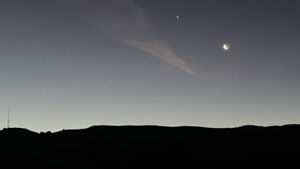
Mercury is best seen when it's at its greatest elongation, meaning it's as far from the Sun as it can get in our sky. This happens when it's about 18 to 28 degrees away from the Sun.
It's often easier to see Mercury from the Southern Hemisphere than from the Northern Hemisphere. This is because of the angle of Mercury's orbit in the sky at certain times of the year.
You can also try to observe Mercury with a telescope during the day, but you must be extremely careful to block out the Sun to protect your eyes. Mercury can also be seen during a total solar eclipse.
History of Observation
Early Views
The earliest known records of Mercury are from ancient Assyrian astronomers around 1400 BC. The Babylonians, around 1000 BC, called it "Nabu," after their messenger god.
The Greek-Egyptian astronomer Ptolemy in ancient times wondered if planets could pass in front of the Sun. He thought if they did, they were either too small to see or it happened too rarely.
In ancient China, Mercury was called "the Hour Star." In modern Chinese, Korean, and Japanese cultures, it's called the "water star." In Hindu mythology, Mercury is named "Budha," who was thought to rule Wednesday.
Telescopic Discoveries
The first people to observe Mercury with a telescope were Thomas Harriot and Galileo in the early 1600s. In 1631, Pierre Gassendi made the first telescopic observation of Mercury passing in front of the Sun, just as Johannes Kepler had predicted. In 1639, Giovanni Zupi used a telescope to see that Mercury had phases, proving it orbited the Sun.
For a long time, it was thought that Mercury was "tidally locked" to the Sun, always showing the same face, just like our Moon always shows the same face to Earth. But in 1965, radar observations by Gordon H. Pettengill and Rolf B. Dyce, using the Arecibo radio telescope, proved that Mercury actually rotates about every 59 days.
This was a big surprise! If Mercury were tidally locked, its dark side would be extremely cold. But radio measurements showed it was much warmer than expected. Then, Italian astronomer Giuseppe Colombo realized that 59 days is about two-thirds of Mercury's 88-day orbit. He suggested the 3:2 spin-orbit resonance, meaning it spins three times for every two orbits. Data from Mariner 10 later confirmed this.
Even with telescopes on Earth, it was hard to see much detail on Mercury. But in 2000, new "lucky imaging" techniques provided clearer views of parts of Mercury not seen by Mariner 10. The Arecibo radar telescope has also mapped most of the planet, even finding what might be water ice at the poles.
-
Transit of Mercury. Mercury is visible as a black dot below and to the left of center. The dark area above the center of the solar disk is a sunspot.
Space Probe Research
Sending a spacecraft to Mercury is very difficult. It's much closer to the Sun than Earth, so a spacecraft has to travel "down" into the Sun's strong gravity. This means it needs a lot of fuel to slow down enough to orbit Mercury. Spacecraft often use "gravity assists" by flying past other planets like Venus to help them change speed and direction.
So far, only three space probes have visited Mercury.
Mariner 10
NASA's Mariner 10 was the first spacecraft to visit Mercury, flying by it in 1974–1975. It was also the first mission to use a gravity assist from another planet (Venus) to reach its target. Mariner 10 sent back the first close-up images of Mercury's surface, showing its many craters and giant cliffs.
The probe made three close passes by Mercury. Each time, the same side of the planet was lit by the Sun, so it could only map less than half of Mercury's surface. During its first pass, Mariner 10 surprisingly detected a magnetic field around Mercury. Scientists didn't expect this because Mercury spins so slowly. The data showed that Mercury's magnetic field is similar to Earth's, pushing away the solar wind.
Mariner 10 ran out of fuel on March 24, 1975, and was shut down. It is still orbiting the Sun, passing close to Mercury every few months.
MESSENGER
NASA launched a second mission to Mercury, called MESSENGER (MErcury Surface, Space ENvironment, GEochemistry, and Ranging), on August 3, 2004. It flew past Earth and Venus to get on the right path. It made three fly-bys of Mercury in 2008 and 2009, mapping most of the hemisphere that Mariner 10 hadn't seen.
MESSENGER successfully entered orbit around Mercury on March 18, 2011. It spent several years studying the planet, sending back high-resolution images and data about its surface, magnetic field, and thin atmosphere.
The mission aimed to answer big questions about Mercury, like why it's so dense, its geological history, its magnetic field, its core structure, and if it has ice at its poles. MESSENGER completed its mission and crashed into Mercury's surface on April 30, 2015, leaving a crater about 16 m (52 ft) wide.
BepiColombo
The European Space Agency (ESA) and the Japanese Space Agency (JAXA) launched a joint mission called BepiColombo on October 20, 2018. This mission has two probes that will orbit Mercury: one to map the planet and another to study its magnetic field.
BepiColombo arrived at Mercury in 2025. It has already completed six flybys of Mercury, with the last one on January 9, 2025. The spacecraft will enter the planet's orbit in 2026. Both probes will work for one Earth year, studying Mercury with various instruments, including those that look at infrared, ultraviolet, X-ray, and gamma ray light.
Images for kids
-
MESSENGER
MASCS spectrum scan of Mercury's surface by MESSENGER.
See also
 In Spanish: Mercurio (planeta) para niños
In Spanish: Mercurio (planeta) para niños


